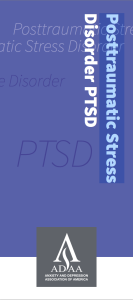
In honor of Mental Health Awareness Month, every Monday, Wednesday and Friday in May, I’ll be breaking down the basics of mental illnesses you said you wanted to read more about.
Mental Health Monday will also accept submissions to be featured throughout the month, whether writing, art, music, audio, video etc. Narratives and creative pieces are welcome. If you’d like to learn more, message me on Facebook or Twitter or email at mleibarnhart@gmail.com. You can read Submission Guidelines Here.
Post-Traumatic Stress Disorder
Post-traumatic stress disorder (PTSD) is a mental illness that can occur after having experienced traumatic, life-threatening or dangerous events. Such events might include personal and sexual assault, witnessing a natural disaster, sudden death of a loved one and war.
The Fifth Edition of the Diagnostic and Statistical Manual of Mental Disorders, a standard classification of mental illnesses and disorders used by mental health professionals in the United States, lists PTSD as a stress-related disorder. But, the disorder is characterized by anxiety and fear due to trauma.
As we learned in “All About Being S.A.D.,” anxiety is a common mental illness, with Generalized Anxiety Disorder affecting nearly 6.8 million Americans. Post-traumatic stress disorder affects 7.7 million Americans over the age of 18, according to the Anxiety and Depression Association of America, and women are twice as likely to develop it. PTSD can affect children and veterans of war. It should be noted that PTSD can occur even if your life is not in danger, and not all people who experience trauma develop PTSD.
Staff Sgt. Stacy Pearsall, a combat photographer, documented her experiences with war, including battles in Iraq, injury and developing PTSD upon returning home. You can watch her experience here from Real Warriors Campaign.
In 2010, HBO released a documentary called “Wartorn,” in which it went through the history of PTSD and war veterans. You might remember your history teachers saying that World War I vets had shell-shock, and World War II vets suffered “combat fatigue.” Both of those illnesses are what we know now as post-traumatic stress disorder. This mental illness dates as far back to the Civil War Era.
What are the symptoms?
To be diagnosed with PTSD, symptoms must last for at least one month, according to the National Institute of Mental Health, and adults must show all of the following symptoms:
Re-experiencing symptoms include…
Avoidance symptoms include…
Arousal and reactivity symptoms include…
Cognition and mood symptoms include…
Symptoms of PTSD can begin showing shortly following a traumatic event, usually within three months. Some people do not experience or show symptoms until years after the event, and symptoms are often accompanied by other anxiety disorders, depression and substance abuse. If you’ve experienced extreme symptoms, similar to the above, that went away in less than a month, you could have Acute Stress Disorder (ASD). If it affects you longer than one month, hinders your daily living, and is directly related to a traumatic event, it is likely PTSD.
Getting Help

Post-traumatic stress disorder is treatable and manageable with the help of mental health professionals and a strong support group. Some of the symptoms show can cause the person with PTSD to act out violently and irrationally, and in some cases, can negatively affect relationships. It’s important to seek help in any way you can.
Some treatments include:
For more information on PTSD, please visit:
Anxiety and Depression Association of America
National Institute of Mental Health
NIMH Getting Help
National Center for PTSD
[…] Read about: PTSD […]
LikeLike
[…] about: PTSD | […]
LikeLike
[…] about: PTSD | OCD | Bipolar […]
LikeLike